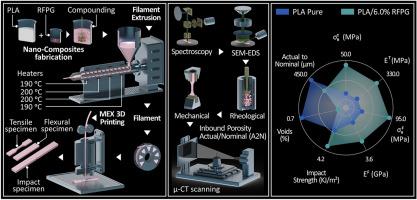Sustainability-driven additive manufacturing: Implementation and content optimization of fine powder recycled glass in polylactic acid for material extrusion 3D printing
Q1 Engineering
International Journal of Lightweight Materials and Manufacture
Pub Date : 2025-03-03
DOI:10.1016/j.ijlmm.2025.02.008
引用次数: 0
Abstract
This work aimed to evaluate the capacity of recycled fine powder glass (RFPG) to reinforce the mechanical performance and characteristics of polylactic acid (PLA) for use in 3D printing (3DP) applications. Six composites with an RFPG filler quantity of 2.0 wt % −12.0 wt % (with a 2.0 step) were evaluated. The raw materials were turned into mixtures, which then fabricated respective filaments. The filaments were inspected and tested for their properties before being utilized to produce the specimens for testing with 3DP. The structures, morphologies, and mechanical properties of the specimens were examined by performing respective tests, scanning electron microscopy, and micro-computed tomography (μ-CT). Moreover, the samples were tested for their thermal properties through thermogravimetric and differential scanning calorimetry analyses, and for their rheological performance. Quality metrics were evaluated with μ-CT (porosity and dimensional accuracy). The findings indicated that RFPG as a filler reinforced the PLA matrix, in the case of 6.0 wt % (23.6 % and 28.7 % strength enhancement in the flexural and tensile tests respectively). The thermal properties were insignificantly changed with a small increase in the crystallization temperature, while the viscosity was significantly lowered with the increase of the powder content in the compounds. The quality metrics were enhanced as well, making this specific RFPG grade a promising filler for the PLA matrix in 3D printing.

可持续发展驱动的增材制造:用于材料挤压3D打印的聚乳酸细粉再生玻璃的实现和含量优化
这项工作旨在评估再生细粉玻璃(RFPG)的能力,以加强用于3D打印(3DP)应用的聚乳酸(PLA)的机械性能和特性。评估了六种RFPG填充量为2.0 wt % ~ 12.0 wt %(步长为2.0)的复合材料。原料被制成混合物,然后制成各自的长丝。细丝被检查和测试了他们的性能,然后被用来生产样品,用3d打印测试。通过扫描电子显微镜和微计算机断层扫描(μ-CT)对样品的结构、形态和力学性能进行了检测。此外,通过热重和差示扫描量热分析测试了样品的热性能,并测试了它们的流变性能。采用μ-CT(孔隙度和尺寸精度)评价质量指标。研究结果表明,RFPG作为填料增强PLA基体,在6.0 wt %的情况下(在弯曲和拉伸试验中分别提高23.6%和28.7%的强度)。随着结晶温度的升高,结晶物的热性能变化不大,而随着粉体含量的增加,结晶物的粘度明显降低。质量指标也得到了提高,使这种特殊的RFPG等级成为3D打印中PLA矩阵的有前途的填料。
本文章由计算机程序翻译,如有差异,请以英文原文为准。
求助全文
约1分钟内获得全文
求助全文
来源期刊

International Journal of Lightweight Materials and Manufacture
Engineering-Industrial and Manufacturing Engineering
CiteScore
9.90
自引率
0.00%
发文量
52
审稿时长
48 days
 求助内容:
求助内容: 应助结果提醒方式:
应助结果提醒方式:


